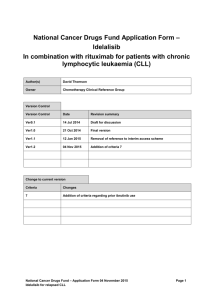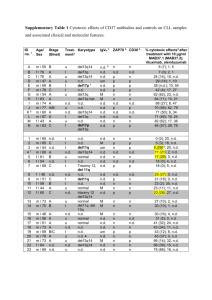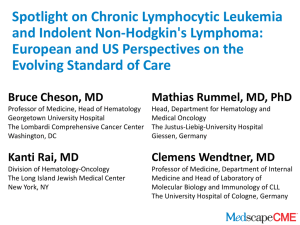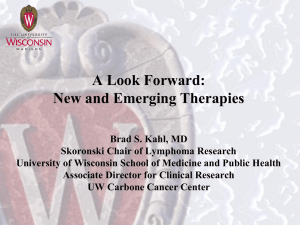Chronic Lymphocytic Leukemia and Mantle Cell Lymphoma ASH Review 2012 Stephen Spurgeon ()
advertisement
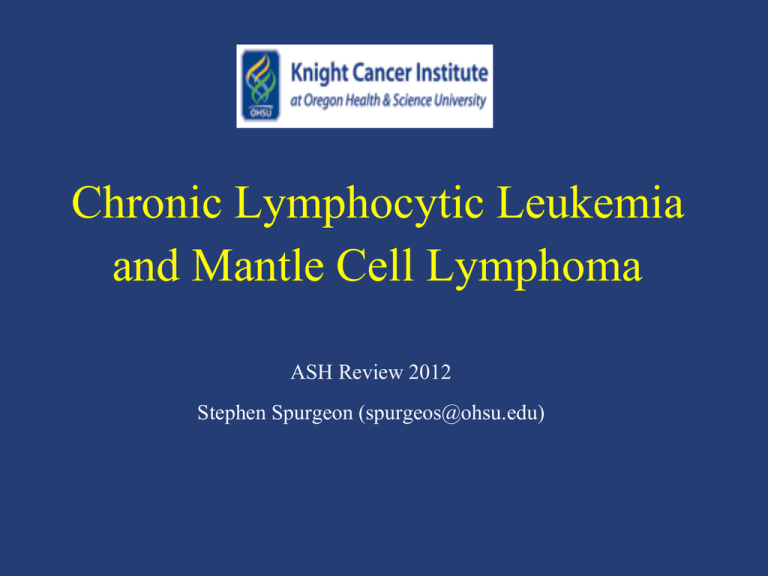
Chronic Lymphocytic Leukemia and Mantle Cell Lymphoma ASH Review 2012 Stephen Spurgeon (spurgeos@ohsu.edu) Disclosures Speakers Bureau: GSK, Millenium, Cephalon CLL: Pertinent Topics ● ● ASH treatment updates ● James DF, et al. ASH 2011. Abstract 291. ● Foa R, et al. ASH 2011. Abstract 294. ● Badoux XC, et al. ASH 2011. Abstract 980. FCR treatment expectations ● ● Fink A, et al. ASH 2011. Abstract 977. Rational therapeutic targets and novel agents Rituximab + Lenalidomide for Patients With Previously Untreated CLL: Phase II ● Patients with previously untreated CLL (n = 69) – Patients younger than 65 yrs of age: n = 40 – Patients 65 yrs of age or older: n = 29 ● Primary endpoint: CR in patients <65 yrs vs. > 65 yrs ● Secondary endpoints – Safety, ORR, PFS James DF, et al. ASH 2011. Abstract 291. Rituximab + Lenalidomide in Previously Untreated CLL: Study Design ● Treatment protocol: 7 cycles – Cycle 1: lenalidomide on 21 of 35 days – Cycles 2-7: lenalidomide on 21 of 28 days Lenalidomide – Day 1: Starting dose: 2.5 mg/day Rituximab – 50 mg/m2 on Day 29 of C 1 – 325 mg/m2 on Day 31 of C 1 – Day 8: Escalated to 5 mg/day – 375 mg/m2 on Day 33 of C 1 – Day 1 cycle 3: increase to 10 mg/day – 375 mg/m2/wk x 4 for cycle 2 – 375 mg/m2 on Day 1 of C 3-7 Tumor lysis syndrome prophylaxis with allopurinol 300 mg/day and oral hydration Thromboprophylaxis (aspirin 81 mg/day) added after 2 cases of pulmonary embolism Methylprednisolone for tumor flare reaction and growth factor support as needed James DF, et al. ASH 2011. Abstract 291. Rituximab + Lenalidomide for Patients With Previously Untreated CLL: Efficacy Outcome Younger Than 65 Yrs (n = 40) 65 Yrs or Older (n = 29) ORR, % CR CRi Nodular PR PR 95 20 0 20 55 78 7 4 0 68 PD 0 4 Median PFS, mos Median follow-up 19 18 20 17 ● ● ORR associated with higher median lenalidomide dose in younger patients (P = .05) Greater exposure to lenalidomide in younger patients vs older patients James DF, et al. ASH 2011. Abstract 291. Rituximab + Lenalidomide for Patients With Previously Untreated CLL: Toxicity AEs, % Any toxicity Grade 1/2 Grade 3/4 Nonhematologic toxicity Grade 1/2 Grade 3/4 Tumor flare reaction No Yes Younger Than 65 Yrs (n = 40) 65 Yrs or Older (n = 29) 33 65 17 69 63 35 38 45 18 83* 41 59 *P = .05 vs older patients. James DF, et al. ASH 2011. Abstract 291. ML21445: Rituximab + Chlorambucil Induction Therapy in Elderly Patients ● Patients with previously untreated CLL (N = 97) – Ineligible for first-line R-FC observation Chlorambucil 8 mg/m2/day Days 1-7 PR, CR Rituximab 375 mg/m2 Day 1 of cycle 3 500 mg/m2 on Day 1 > C4 ● ● 8 cycles (q 28 days) Primary endpoint: ORR at end of induction Foa R, et al. ASH 2011. Abstract 294. R 375 mg/m2 8 wks for 12 doses ML21445: Responses Response Following Induction, % Patients (ITT) (N = 85) ORR All patients 81.2 Response Following Induction, % Binet stage A 86.0 CR/CRi Binet stage B 80.0 PR 60.0 Binet stage C 79.0 PD 3.5 60-64 yrs of age 84.0 65-69 yrs of age 85.0 70-74 yrs of age or older 75.0 75 yrs of age 81.0 *By flow cytometry. Foa R, et al. ASH 2011. Abstract 294. Patients (ITT) (N = 85) 19 ML21445: Efficacy ● ● No correlation between treatment response and standard prognostic factors Pretreatment gene expression differed between responders and nonresponders – Up-regulation of transcripts relevant to pro-proliferative and antiapoptotic pathways, including Ras (K-Ras, N-Ras) and Rho – Up-regulation of genes related to protein metabolism – CD20 down-regulation detected by gene profiling (P = .018 vs responders) but not by flow cytometry (P = .19 vs responders) Foa R, et al. ASH 2011. Abstract 294. ML21445: Toxicity ● ● ● Chlorambucil dose reduction required in 7.8 % of cycles Grade 3/4 Hematologic AEs during induction: – Neutropenia: 19.6% – Thrombocytopenia: (1.0%) – Infections: (1.0%) Grade 3/4 neutropenia during maintenance: – 11.8% with rituximab vs 3.1% on observation Foa R, et al. ASH 2011. Abstract 294. Identifying High Risk for Progression in CLL Patients Receiving FCR ● CLL8 study: FC vs FCR as primary CLL therapy[1] – Median PFS: 57.9 mos FCR vs 32.9 mos FC (P < .0001) – OS dependent on length (< vs ≥ 2 yrs) of PFS (P < .001) – shortened PFS: – ● del(17p) + TP53 mutations ● MRD,[2] IgVH unmutated status,[3] shorter PFS Elevated β2-microglobulin or high WBC count not predictive of short PFS 1.. Hallek M, et al. Lancet. 2010;376:1164-1174. 2. Boettcher S, et al. ASH 2008. Abstract 326. 3. Stilgenbauer S, et al. ASH 2008. Abstract 781. Identifying High Risk for Progression in CLL Patients on FCR: Study Design ● Subset analysis of GCLL CLL8[1] randomized phase III trial (FC vs. FCR) – ● FCR-treated patients from CLL8 with short PFS and MRD at final restaging (N = 143) Definition of high risk for early progression – MRD levels > 10-2 or – MRD levels > 10-4 to < 10-2 plus either ● del(17p), TP53 mutation, or IgVH unmutated status Fink A, et al. ASH 2011. Abstract 977. 1.. Hallek M, et al. Lancet. 2010;376:1164-1174 Identifying High Risk for Progression in CLL Patients Receiving FCR: PFS and OS ● Survival outcomes significantly better in patients with CLL and low risk – – Median PFS in low-risk vs high-risk patients ● 69 vs 22 months ● HR: 6.4 (95% CI: 3.97-10.347; P < .0001) Median OS in low-risk vs high-risk patients ● Not reached vs 57 mos ● HR: 5.758 (95% CI: 2.799-11.844; P < .0001) Fink A, et al. ASH 2011. Abstract 977. Lenalidomide + Rituximab Combination in Relapsed/Refractory CLL: Efficacy Outcome Patients (N = 59) Clinical best response, % ORR 66 CR* 12 Nodular PR 12 PR 42 36-mo OS, % (95% CI) Median PFS, mos (95% CI) *Minimal residual disease-negative CR. Badoux XC, et al. ASH 2011. Abstract 980. 75 (64-87) 17.4 (11.9-23.0) Lenalidomide + Rituximab Combination Therapy in Relapsed/Refractory CLL ● ● Patients with relapsed/refractory CLL (N = 59) Treatment protocol: 28-day cycles – Rituximab 375 mg/m2 ● ● ● – – ● Cycle 1: Days 1, 8, 15, 22 Cycle 2: no administration Cycles 3-12: Day 1 Lenalidomide 10 mg/day starting Day 9 Allopurinol 300 mg orally Days 1-14 for tumor lysis prophylaxis Primary endpoint: ORR – ITT analysis – Assessed at end of cycles 3, 6, then Q 6 months Badoux XC, et al. ASH 2011. Abstract 980. Lenalidomide + Rituximab Combination in Relapsed/Refractory CLL: Efficacy Lenalidomide/rituximab responses not correlated with disease biology ● – Rai stage, bulky disease, cytogenetics by FISH: correlation insignificant Fludarabine refractory patients do worse ● Lower ORR (P < .05) ● Shorter PFS (P = .019) Badoux XC, et al. ASH 2011. Abstract 980. Lenalidomide + Rituximab Combination in Relapsed/Refractory CLL: Toxicity Grade 3/4 AEs, n (%) Patients (N = 59) Neutropenia 43 (73) Thrombocytopenia 20 (35) Anemia Any infection Pneumonia/bronchitis ● Frequent grade 1/2 AEs – Fatigue (37%) 9 (15) – Diarrhea (36%) 14 (24) – Tumor flare (27%) 6 (10) – Sensory neuropathy (24%) – Rash (22%) Febrile neutropenia 6 (10) Hypercalcemia* 1 (2) Gastrointestinal 3 (5) Tumor lysis 1 (2) VTE 1 (2) Pain 1 (2) Weakness 1 (2) Arrhythmia 1 (2) Badoux XC, et al. ASH 2011. Abstract 980. ● 4 patients experienced secondary malignancies on treatment – Myelodysplastic syndrome: n = 1 – Squamous cell carcinoma: n = 1 – Melanoma in situ: n = 1 – Head/neck cancer recurrence: n = 1 Summary ● ● ● ● Rituximab + lenalidomide active, well tolerated in both younger and older patients (younger than 65 or 65 yrs or older) with previously untreated CLL but produced higher ORR and CR in the younger cohort Rituximab + chlorambucil induction therapy active, well tolerated in elderly patients with previously untreated CLL In patients with CLL receiving FCR, cytogenetic analysis plus MRD detection identifies patients at high risk of disease progression Lenalidomide + rituximab combination is active as salvage therapy for patients with relapsed/refractory CLL and has a manageable AE profile; response rates were lower among patients with fludarabine-refractory disease CLL is a Complex Disease Diagram courtesy of Jan Burger Therapeutic targeting of the BCR Signaling Pathway Stevenson et al. Blood. 2011. Rationale for Targeting PI3K-δ in CLL • PI3-kinase active in CLL vs normal B-cells • PI3K-δ inhibition in CLL cells promotes ↑ Apoptosis ↓ Proliferation ↓ Chemokines ↓ Microenvironment response Herman S et al: Blood 2010 Lanutti B, et al: Blood 2011 Phase I Cal-101 (GS-1101) Patient Demographics Characteristics N=55 Sex, males/females, % 82/18 Age, median[range], years 63 [37-82] Bulky adenopathy (5 cm), % 82 Adverse genetics, % del(17p) 31 Relapsed/refractory disease, % Prior therapies, median [range], n 29/71 5 [2-15] Prior therapy type, % Fludarabine Rituximab Alkylating agent Alemtuzumab 100 98 87 33 CAL-101 (GS-1101) Response in CLL Coutre S, et al: ASCO 2011 Patient B.C. Diagnosed with CLL in 2002 70 year old man with relapsed bulky CLL Since 2005: 8 treatment regimens 2010 progressive disease Refractory CLL-pre treatment Refractory CLL-after 1 cycle of CAL-101 GS-1101 Progression Free Survival Coutre S, et al: ASCO 2011 GS-1101 Grade 3-4 Toxicity Coutre S, et al: ASCO 2011 Where is GS-1101 Going in CLL? ● Completion of phase I or II studies in untreated and relapsed CLL – GS-1101 +combinations (Sharman et al. Abstract # 1787) ● Registration studies in CLL ● OHSU expects to have: – GS1101 (CAL-101) registration trial for relapsed CLL – Novel combinations with other kinase inhibitors The Bruton’s Tyrosine Kinase (BTK) Inhibitor PCI-32765 Induces Durable Responses in Relapsed or Refractory (R/R) Chronic Lymphocytic Leukemia/Small Lymphocytic Lymphoma (CLL/SLL): Follow-up of a Phase Ib/II Study (abstract # 983) SUSAN O'BRIEN, MD1, JAN A. BURGER, MD, PHD1, KRISTIE A. BLUM, MD2, RICHARD R. FURMAN, MD3, STEVEN E. COUTRE, MD4, JEFF SHARMAN, MD5, IAN W. FLINN, MD, PHD6, BARBARA GRANT, MD7, NYLA A. HEEREMA, PHD2, AMY J. JOHNSON, PHD2, TASHEDA NAVARRO8, ERIC HOLMGREN, PHD8, ERIC HEDRICK, MD8 AND JOHN C. BYRD, MD2 1Department of Leukemia, The University of Texas MD Anderson Cancer Center, Houston, TX 2Division of Hematology and The Department of Pathology, The Ohio State University, Columbus, OH 3Department of Medicine, Division of Hematology-Oncology, Weill Cornell Medical College, New York, NY 4Divisions of Hematology and Oncology and Stanford Cancer Center, Stanford University School of Medicine, Stanford, CA 5US Oncology, Springfield, OR 6Sarah Cannon Research Institute, Nashville, TN 7Medicine, Vermont Cancer Center, University of Vermont, Burlington, VT 8Pharmacyclics, Inc, Sunnyvale, CA Relapsed/Refractory PCYC-1102-CA 420 mg/d (n=27) Dates enrolled: 5/20/10–9/27/10 Treatment Naïve ≥ 65 yrs 420 mg/d (n=26) Dates enrolled: 6/2/10–4/5/11 PCYC-1102-CA Total enrollment 117 patients Relapsed/Refractory 840 mg/d (n=34) Dates enrolled: 10/9/10–4/5/11 High-risk Relapsed/Refractory 420 mg/d (n=25) Dates enrolled: 6/9/11–7/27/11 Treatment Naïve ≥ 65 yrs 840 mg/d (n=5) Dates enrolled: 5/31/11–7/8/11 31 Patient Characteristics (cont.) 420 mg/d (N=27) 840 mg/d (N=34) Total (N=61) 6/26 (23) 4 (15) 8 (30) 9 (33) 17 (50) 18 (53) 24 (71) 27 (79) 23/60 (38) 22 (36) 32 (52) 36 (59) 17/25 (68) 9 (33) 8 (30) 9/25 (36) 18/31 (58) 10 (29) 12 (35) 20/32 (63) 35/56 (63) 19 (31) 20 (33) 29/57 (51) 11 (41) 16 (59) 13/33 (39) 20/33 (61) 24/60 (40) 36/60 (60) Refractory, # (%) 10 (37) 17 (50) 27 (44) Bulky Disease, # (%) ≥ 5 cm 13 (48) 1 (4) 20 (59) 9 (26) 33 (54) 10 (16) Cytopenia at baseline, # (%) ANC < 1500/μL HGB < 11g/dL Platelets < 100,000/μL HGB < 11g/dL or PLT < 100,00 μL Prognostic Markers, # (%) IgVH unmutated: Del(17p): Del(11q): β2 Microglobulin > 3mg/L ECOG Performance Status, # (%) 0 1/2 ≥ 10 cm 32 Best Response CR 420 mg/d (N=27) 1 (4) 840 mg/d (N=34) 0 (0) Total (N=61) 1 (2) PR 17 (63) 23 (68) 40 (66) ORR* 67% 68% 67% Nodal 6 (22) 8 (24) 14 (23) SD 1 (4) 1 (3) 2 (3) PD 1 (4) 0 (0) 1 (2) NE 1 (4) 2 (6) 3 (5) *Per IWCLL 2008 criteria Splenomegaly before and after 2 months of PCI-32765 Before PCI-32765 2 months of PCI-32765 Pattern of Response: Blood Lymphocytes vs Lymph Nodes Best Response by Risk Features All Patients n/N 41/60 ORR % 68 Hgb < 11 g/dL or PLT < 100K/μL at screening 35/60 58 Del 17p 12/18 67 Del 11q 14/20 70 IgVH unmutated 26/35 74 β2 Microglobulin > 3mg/L 19/29 66 ≥ 70 years age 13/18 72 Refractory disease 17/26 65 Bulky disease ≥ 5 cm 24/33 73 Bulky disease ≥ 10 cm 7/10 70 Progression-free Survival by 17p Del Status Common AEs (All Grades) Events occurring in > 15% of Patients (n=61) Grade 1 Grade 2 Grade 3 Grade 4 Grade 3/4 Infectious and Hematologic Toxicity Grade 3/4 Hematology toxicity 1 420 mg/d (n=27) 840 mg/d (n=34) Grade 3 Grade 4 Grade 3 Grade 4 Neutropenia 4% 4% 12% 9% Anemia 7% 0% 9% 3% Thrombocytopenia 0% 7% 9% 0% Grade 3/4 Infectious toxicity Patients with any Grade 3/4 (%, %) 420 mg/d (n=27) 840 mg/d (n=34) 5/2 (19%, 7%) 9/1 (26%, 3%) 1 Reported as AEs Dasatinib in CLL ● ● Inhibits SRC, LYN, BTK Results published on 15 relpased/refractory patients ● ORR 20% ● Nodal response 66% ● Can we do better? Amrein et al. Clinical Cancer Research 2011 Dasatinib in CLL at OHSU Can we predict who will respond to treatment? ● Dasatinib Clinical Trial (NCT01441882) – Relapsed/refractory of if age > 70, Tx naive – Test patient CLL samples in the lab – Only enroll patients on trial if the drug first demonstrates in vitro killing activity – Measure cell death signaling pathways – Examine signaling and gene expression in vivo while receiving treatment C-F: Response to treatment C-F pretreatment scan C-F after 6 months of dasatinib Lymphocyte Count CF Response to treatment 93 % change from baseline Summary: Targeting BCR signaling in CLL ● ● ● ● ● Promising activity including in poor risk patients Most effective for nodal disease Often results in lymphocytosis as CLL cells are mobilized from the micro-environement Well tolerated, oral agents Studies to predict response and with novel combinations are ongoing Mantle Cell Lymphoma ● Role of Rituximab – ● R-Cladribine Based Treatment – ● Kluin-Nelemans, et al. ASH 2011. Abstract 439 Spurgeon, et al. ASH 2011. Abstract 441 PCI 32765 in Mantle Cell Lymphoma – Wang, et al. ASH 2011. Abstract 442 MCL: Poor Prognosis and Long–Term Outcome 18 months Patients at risk R-CHOP 58 45 28 15 5 CHOP 44 35 17 10 3 1 Progression-free survival after CHOP and R-CHOP There were no significant differences between the two treatment arms (P=0.31) Lenz G. et al. J Clin Oncol. 2005;23:1984-1992. Percentage Surviving Possible Improved Survival in Elderly Patients Receiving Rituximab Griffiths, R, et. al. Blood 2011 Nov 3;118(18):4808-16 R-Maintenance ● SAKK[1] – ● GLSG[2] – ● NO BENEFIT after R induction PFS BENEFIT after R-FCM induction Modified R-HyperCVAD[3] – – – 2 years of R-Maintenance PFS = 37 months Median OS = 70 months 1. Ghielmini M, et al. J Clin Oncol. 2005, 2. Forstpointner, R, et al. Blood 2006) , 3. (Kenkre, V, et al. Leuk Lymphoma 2011) R-CHOP vs R-FC followed by maintenance with Rituximab vs. Interferon-alfa in elderly patients with Mantle cell lymphoma Hanneke C. Kluin-Nelemans for the European MCL Network University Medical Center Groningen The Netherlands First RCT for MCL Elderly 8 countries, n = 560 (Jan 2004-Oct 2010) Newly diagnosed, >60-65 yr; performance 0-2, Stages II-IV, central PA review 8 x R-CHOP IFN-a maintenance (3 x 3 M IU/week) or Peg-IFN (1mg/kg week) PR, CR 6 x R-FC Rituximab maintenance (all 2 months) MCL Elderly: Baseline Characteristics 1st randomization Parameter Age median (range) % male Stage IV % pos. BM B-Symptoms Performance 0-1 Elevated LDH MIPI low risk MIPI intermediate risk MIPI high risk n R-CHOP (%) 70 (61-87) 68 83 76 38 92 R-FC (%) 70 (60-85) 72 81 75 38 93 44 7 43 50 43 9 39 52 280 280 MCL Elderly: Overall survival R-CHOP R-FC MCL elderly study toxicity R-CHOP vs R-FC 100 80 60 40 100 20 90100 0 90 80 80 70 70 60 60 50 50 40 40 30 30 20 20 10 10 0 0 Hb p=0.016 WBC p=0.005 Lympho p=0.011 Neutrophils Platelets p=0.25 p<0.001 R-CHOP Grade 3-4 R-CHOP Grade 1-2 R-FC Grade 3-4 R-FC Grade 1-2 Mucositis Cardiac Neuropathy Alopecia Infections Febrile Mucositis Cardiac Pulm Pulm Neuropathy Alopecia Infections Febrile function neutropenia functionfunction function neutropenia p=0.063 p=0.063p=0.70 p=0.70 p>0.99 p>0.99 p<0.001 p<0.001p<0.001 p<0.001p=0.004 p=0.004p=0.085 p=0.085 R-CHOP Grade R-CHOP Grade R-CHOP Grade 3-43-4R-CHOP Grade 1-21-2 R-FC Grade R-FC Grade R-FC Grade 3-43-4 R-FC Grade 1-21-2 MCL Elderly study Remission duration maintenance Intention-to-treat analysis Rituximab IFN 22-10-2011 MCL Elderly study Remission duration related to induction R-CHOP R-FC p=0.18 for interaction of induction and maintenance 22-10-2011 MCL Elderly: overall survival related to induction regimen After R-CHOP After R-FC p=0.0223 for interaction of induction and maintenance 22-10-2011 Toxicity of IFN and Rituximab 90 80 70 60 50 40 30 20 10 0 Hb 100 90 p=0.94 80 70 60 50 40 30 20 10 0 Depression p=0.16 WBC p=0.002 Lympho p=0.054 IFN Grade 3-4 R Grade 3-4 Fatigue p<0.001 IFN Grade 3-4 R Grade 3-4 Neutro Platelets p=0.20 p=0.001 IFN Grade 1-2 R Grade 1-2 Infections p=0.022 IFN Grade 1-2 R Grade 1-2 R-cladribine based Therapies for MCL Median PFS 37.5 months Median OS 85 months Spurgeon et. al, Leukemia & Lymphoma, 2011 R-cladribine based Therapies for MCL Spurgeon et. al, Leukemia & Lymphoma, 2011 Phase I/II Study of Vorinostat (SAHA), Cladribine (2-CdA), and Rituximab Shows Significant Activity in Previously Untreated Mantle Cell Lymphoma Stephen E. Spurgeon,MD1, David F. Claxton, MD2, W. Christopher Ehmann, MD2, Samir S. Parekh, MD,3 Violetta Leshchenko, PhD3, Motomi Mori, PhD2, Sara Shimko, BA,2 August Stewart, BA,2 Elliot M. Epner, MD PhD2 1. Knight Cancer Institute at Oregon Health & Science University, Portland, OR 2. Penn State Hershey Cancer Institute, Hershey, PA 3. Albert Einstein College of Medicine, Bronx, NY Study Rationale ● Cladribine has cytotoxic and epigenetic properties ● Vorinostat (SAHA): – inhibits class I and II histone de-acetylases (HDAC) – has shown clinical activity in B-cell lymphomas1 – ● increases tumor suppressor gene expression when combined with a hypomethylating agent2-4 Cladribine and HDAC inhibition are synergistic as evidenced by increased in vitro apoptosis in primary CLL cells.5 1. 2. 3. 4. 5. Human Pathology 2007;38(12):1849-1857 J Clin Oncol. 2011 Mar 20;29(9):1198203. Cancer Sci. 2010 (1):196-200 Blood. 2010 Aug 19;116(7):1025-34 Br J Haematol. 2009 Jan;144(1):41-52. Inclusion Criteria ● Treatment Population – Phase I: relapsed CD20+ NHL, CLL – Phase II: Two cohorts ● Relapsed CD20+ NHL, CLL ● Previously untreated MCL Primary Study Objectives Phase I ● Safety and toxicity Phase II ● Response rates ● Tolerability and toxicity Secondary Objectives ● Progression free survival ● Overall survival ● DNA methylation, histone deacetylation, and changes in target gene expression ● ● Phase I Phase II dosing – No MTD reached – Responses were seen in MCL and SLL Phase II vorinostat dose 400 mg/day, days 1-14 cycle > 1 Rituximab once per cycle Phase II: Response in Relapsed Cohort (n =17) Population Total MCL 10 MZL 3 2 (66%) 1 CR, 1 PR FL 1 1 PR (100%) Relapsed CLL 3 0 NHL Response by Modified Cheson Criteria CLL Response by IWCLL Criteria ITT Overall Response (%) 2 (20%) 2 CR Phase II: Previously Untreated Mantle Cell Cohort ( n=21) Median Age (range) Characteristic 64 ( 42-87) Number of Patients (%) Age > 60 Stage IV Blastic Histology MIPI* low intermediate high 14 (70%) 20 (95%) 4 (19%) B2 M > 3.0 g/dl 11 (52%) 11 (52%) 4 (19%) 6 (29%) * Mantle Cell International Prognostic Index Phase II: Clinical Response in Previously Untreated MCL Cohort (n =20) Response (%) Complete Remission (%) Partial Remission (%) 20 (100%) 5 ( 25%) 15 (75%) Phase II Toxicity: Most Prevalent Adverse Events Event Frequency (158 treatment cycles) Hematologic Gr. 3 Gr. 4 50 (32%) (11%) 32 (20%) 8 (5%) 17 6 (4%) 3 (2%) 0 0 Neutropenia Thrombocytopenia Anemia 8 (5%) 0 Non Hematologic Fatigue Infection Grade 5 Pulmonary Hemorrhage 1 (1%) Study currently enrolling patients at OHSU * Off study Months Summary: Mantle Cell Lymphoma ● ● • • Induction therapy with R-CHOP vs R-FC favors R-CHOP: more overall responses, less toxicity Rituximab maintenance doubles the remission duration in patients responding upon initial therapy Vorinostat , cladribine , and rituximab is safe and effective regimen for lymphoid malignancies • All previously untreated MCL patients responded • 75% CR PCI-32765 active and well tolerated in relapsed MCL Reference/Backup Slides Tumor Microenvironment ● ● CLL cells – Migrate to stromal cell layer which is protective – Secrete CCL3 and CCL4 which attracts T cells Lymph Nodes – ● CD40L engaged with CD40 on T-cells More sensitive to chemotherapy if removed from protective niche Nurse-like cells ● Marrow stromal cells and nurse like cells – Secrete CXCL 12 and CXCL 13 – Attract CLL cells (via chemokine receptors CXCR4 and CXCR5) * Nishio M et al. Blood 106:1012-20, 2005 ¶ Burkle A et al. Blood 110:3316-25, 2007 † Burger JA et al. Blood 96, 2655-63, 2000 ‡ Deaglio S et al. Blood 105(8):3042-50, 2005 ● ● ● Distinct differences between node and peripheral blood Increased expression of CCL3 and CCL4 in lymph nodes Increased expression of MYC Y Herishanu et al., Blood. 2011 Jan 13;117(2):563-74 JA Burger et al. Blood. 113(13):3050-8, 2009 CCL3 and CCL4 levels affect prognosis Sivina M et al, Blood 117:1662-9, 2011 A Phase 1 Study of the Selective Phosphatidylinositol 3-Kinase-Delta (PI3K) Inhibitor, GS-1101 (CAL-101), in Combination with Rituximab and/or Bendamustine in Patients with Relapsed or Refractory Chronic Lymphocytic Leukemia (CLL) Jeff Sharman1, Sven de Vos2, John P. Leonard3, Richard R. Furman3, Steven E. Coutre4, Ian W. Flinn5, Marshall T. Schreeder6, Jacqueline Barrientos7, Nina D. Wagner-Johnston8, Thomas E. Boyd9, Nathan Fowler10, Leanne M. Holes11, Harriet (Sissy) Peterman11, Brian J. Lannutti11, Dave M. Johnson11, Thomas M. Jahn11, Langdon L. Miller11 1US Oncology Research and Willamette Valley Cancer Institute and Research Center, Springfield, OR; 2University of California Los Angeles, Los Angeles, CA; 3Weill Cornell Medical College, New York, NY; 4Stanford University Cancer Center, Stanford, CA; 5Sarah Cannon Research Institute and Tennessee Oncology, PLLC, Nashville, TN; 6Clearview Cancer Institute, Huntsville, AL; 7Long Island Jewish Medical Center, New Hyde Park, NY; 8Washington University, St. Louis, MO; 9US Oncology Research and Yakima Valley Memorial Hospital, Yakima, WA; 10University of Texas, MD Anderson Cancer and Research Center, Houston, TX; 11Gilead Sciences, Inc., Seattle, WA Reference: Sharman, ASH 2011, #1787 In Previously Treated CLL, GS-1101 (CAL-101) Has Been Evaluated as Monotherapy and in Combination Therapy Phase 1b Monotherapy Study Phase 1b Combination Study GS-1101 GS-1101 GS-1101 GS-1101 GS-1101 50 to 350 mg BID 100 or 150 mg BID 150 mg BID 100 or 150 mg BID 150 mg BID Rituximab Fludarabine Bendamustine + 375 mg/m2 weekly C1 and C2 + 40 mg/m2 P.O. Days 1 – 5 C1 – C6 + + Rituximab 375 mg/m2 D1 C1 – C6 70 or 90 mg/m2 Days 1 and 2 C1 – C6 + Bendamustine 70 or 90 mg/m2 Days 1 and 2 C1 – C6 Designs: Phase 1-2 dose-ranging trials Endpoints: Recommended dosing regimen, safety, antitumor activity Follow-up: After 48 weeks, patients who continue to benefit can continue GS-1101 single-agent therapy on an extension study ITT Responsea Rate 95% CI GS-1101 Combination Therapies Substantially Increased Overall Response Rate G Mono (N=55) G+R (N=19) 100 80 84% n=46 84% n=16 84% n=16 LNR OR 60 G+F (N=7) G+B (N=14) 71% n=5 71% n=5 LNR OR 79% n=11 79% n=11 G+R+B (N=14) 86% n=12 86% n=12 LNR OR 40 20 24% n=13 0 a b Decrease by 50% in the nodal SPD Response by IWCLL criteria [Hallek 2008] LNR OR Both GS-1101 Monotherapy and Combination Therapy were Associated with Durable Tumor Control GS-1101 Mono G+R (N=19) G+F (N=7) % Progression-free (N=55) G+B (N=14) G+R+B (N=14) 100 75 50 25 0 BL 2 4 6 8 10 12 BL 2 4 6 8 10 12 BL 2 4 6 8 Cycles (4 weeks) GS-1101 monotherapy: Median PFS >12 months GS-1101 combination therapy: Median PFS not yet reached 10 12 Adverse Event Profiles Have Been Generally Consistent with the Known Safety Profiles of Each Agent Grade 3 Adverse Events (Regardless of Cause) % (n) Mono Combination GS-1101 (N=63) GS-1101 + R (N=19) GS-1101 +B (N=20) GS-1101 + BR (N=13) All Comb. (N=52) Anemia 10% (6) 5% (1) 10% (2) ̶ 6% (3) Neutropenia 11% (7) 32% (6) 25% (5) 23% (3) 27% (14) Febrile neutropenia 2% (1) ̶ 10% (2) ̶ 4% (2) Thrombocytopenia 8% (5) 5% (1) 15% (3) 8% (1) 10% (5) ALT/AST elevated 22% (14) 21% (4) 30% (6)* ̶ 19% (10)* Cardiac arrest ̶ 5% (1) ̶ ̶ 2% (1) Colitis ̶ 5% (1) ̶ ̶ 2% (1) Fatigue 6% (4) 5% (1) 10% (2) ̶ 6% (3) Pneumonia/Pneumonitis 13% (8) 11% (2) 35% (7) ̶ 17% (9) Rash 3% (2) 5% (1) 10% (2) 8% (1) 8% (4) ̶ ̶ 5% (1) ̶ 2% (1) Sepsis * Only 1 pt experienced repeated ALT/AST elevations upon GS-1101 re-exposure


